Definition
Seizure is the main parozysmal disorder of the newborn, characterized by the sudden onset of neurological dysfunction which causes unexpected changes in behavior. Seizure is an essential manifestation of epilepsy, but not all of them develop into this disorder.
Causes
Some common causes include: developmental problems, genetic conditions present at birth, or injuries near the time of birth ( seizures usually begin in infancy or early childhood ).
Clinical Manifestations
Seizure types are organized according to whether the source of the seizure within the brain is localized or distributed.
Partial seizures are further divided on the extent to which consciousness is affected or not. Simple partial seizure is unaffected; whereas complex partial seizure isaffected. Partial seizures are the most common type of seizure experienced by people with epilepsy. Virtually any movement, sensory, or emotional symptom can occur as a part of a partial seizure, including complex visual or auditory hallucinations.
Generalized seizures are divided according to the effect on the body, but all involve loss of consciousness.
- Tonic phase : usually lasts for tens of seconds. The individual suddenly loses consciousness, emitting a piercing cry or haunting moan. The eyes roll back in the head; muscles throughout the face, trunk, and limbs become rigid in a tonic contraction. The person falls, unprotected, to the ground. Often the tongue is bitten. More frighteningly, breathing stops and the person begins to turn blue. Sphincter control is lost; urine and sometimes stool are passed.
- Clonic phase : the muscles relax and then contract again with rhythmic jerks. It is not uncommon for this phase to last for 30 minutes or more.
Diagnosis
An electroencephalogram ( EEG, brain wave activity ) helps to distinguish epileptic seizures from other types of spells, such as psychogenic non-epileptic seizures, fainting, movement disorders and migraine variants, while brain imaging with computed tomography ( CT ) scan or magnetic resonance imaging ( MRI ) scan can be used to determined brain occupied lesion or other brain pathologic condition that disrupts the brain's natural circuitry. Blood tests, lumbar puncture or toxicology screening can be helpful in specific circumstances suggesting an underlying cause like meningitis or drug overdose.
Treatment
Good habits may help to control seizures. Like a good sleep habit, stress reduction, proper exercise, and sound nutrition may help to decreased seizures.
There is no specific way to prevent seizures. People with seizure should take medication as directed and avoid excessive amounts of alcohol.
Attentions
While the convulsion breaks out :
- Stay with the person until he/she recovers or seek for professional medical help. Monitor their pulse, breathing rate, and blood pressure.
- Do not give the person anything by mouth until the convulsions have stopped and the person is fully awake and alert.
- Do not move the person unless he/she is in danger or near something hazardous.
- Do not put anything between the person's teeth during a seizure.
- Do not restrain the person.
- Do not try to make the person stop convulsing. He/she can't control the seizure and is not aware of what is happening at the time.
- Do not break off the medication arbitrarily
- Make him/her lying on the side to obviate secretion form his/her mouth and smooth breathing.
- When they are asleep or have a rest, make sure they won’t fall from their bed to prevent injury.


